The animal world features a fascinating and diverse range of hunting strategies. For some species, hunting cooperatively helps ensure group and individual survival and increases the ability to take down tricky, elusive, or large prey. Some animals even cooperate with other species during predation.
Most animals that hunt socially also live in social groups. Animals that live solitarily by and large also hunt alone, although there are some exceptions that we’ll delve into below. To succeed as cooperative hunters, animals use group coordination and various methods of communication to work together. For these animals, social cohesion, even temporarily, is an important aspect of a successful hunt.
In this guide, we’ll discuss nine animals that hunt cooperatively. Read on to learn more!
Wolves (Canis lupus)
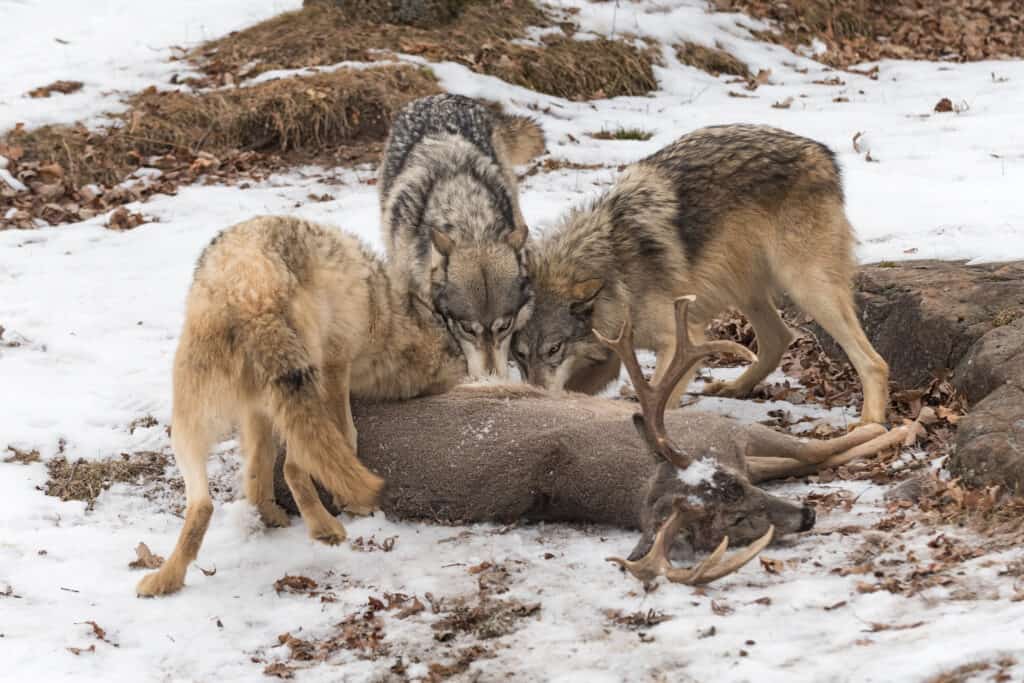
Wolves hunt and feed together in bonded social groups.
©Geoffrey Kuchera/Shutterstock.com
When we think of social land animals that hunt together, wolves are often one of the first critters to come to mind. And for good reason- wolves are highly adept social predators that can work almost seamlessly in cooperation to take down large prey. These wild canids simply could not succeed so well in taking down healthy, adult ungulates, such as elk or caribou, without group coordination. To successfully hunt together, wolves primarily communicate using vocalizations, facial expressions, and body language.
Interestingly, for wolves, group size can affect predation outcomes depending on the species being hunted. One study that observed pack hunting behaviors in Yellowstone wolves compared their strategies and success when hunting bison versus elk.
Researchers found that the highest success rate for elk hunting ranged from 2-6 wolves, with success decreasing with pack hunts larger than 6 individuals. However, during bison hunts, researchers observed that the prime range was 9-13 wolves, although evidence also suggested that may do even better hunting bison with numbers greater than 13. The conclusion of this research suggests that group hunting with large numbers of wolves during lower-stake hunts may actually impede success, whereas high-stake hunts of more dangerous prey resulted in increased cooperation and cohesion among large numbers of wolves.
Animals That Hunt Cooperatively: Lions (Panthera leo)
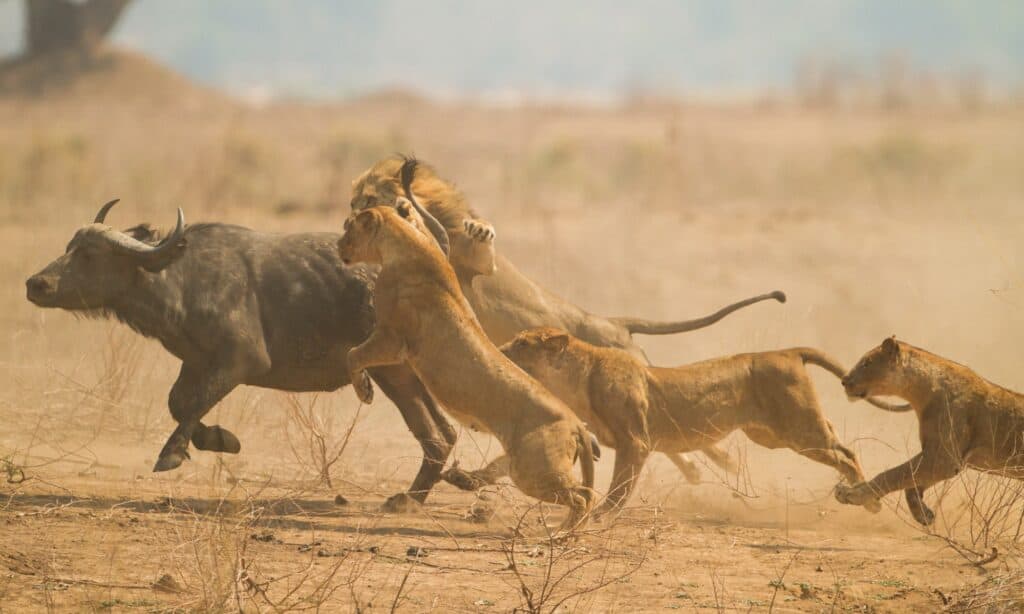
Lions hunt cooperatively to take down large, dangerous prey.
©iStock.com/jez_bennett
Another well-known example of a social hunter is the majestic lion (Panthera leo). While some big cats are solitary hunters, such as tigers and leopards, lions overwhelmingly hunt cooperatively. This social hunting behavior is typically seen among the lionesses of a pride and in small coalitions of 2-4 male bachelors. Male lions in established prides often hunt on their own by using thick vegetation to ambush prey. Both African and Asiatic lions follow these general hunting behaviors.
One study on cooperative hunting in lions in the semi-arid plains of Namibia analyzed data from 486 coordinated hunts of lionesses. They found that group hunts generally involved two main formations: individuals who flanked and circled prey and individuals who acted as “centers”, waiting for prey to be pushed toward them. The flanking individuals usually initiated the stalking and chase while the center lionesses typically completed capture as the prey ran from the flanking lions. This study found a correlation between a successful hunt and individual lionesses being able to take up their repeated, preferred positions.
Spotted Hyenas (Crocuta crocuta)
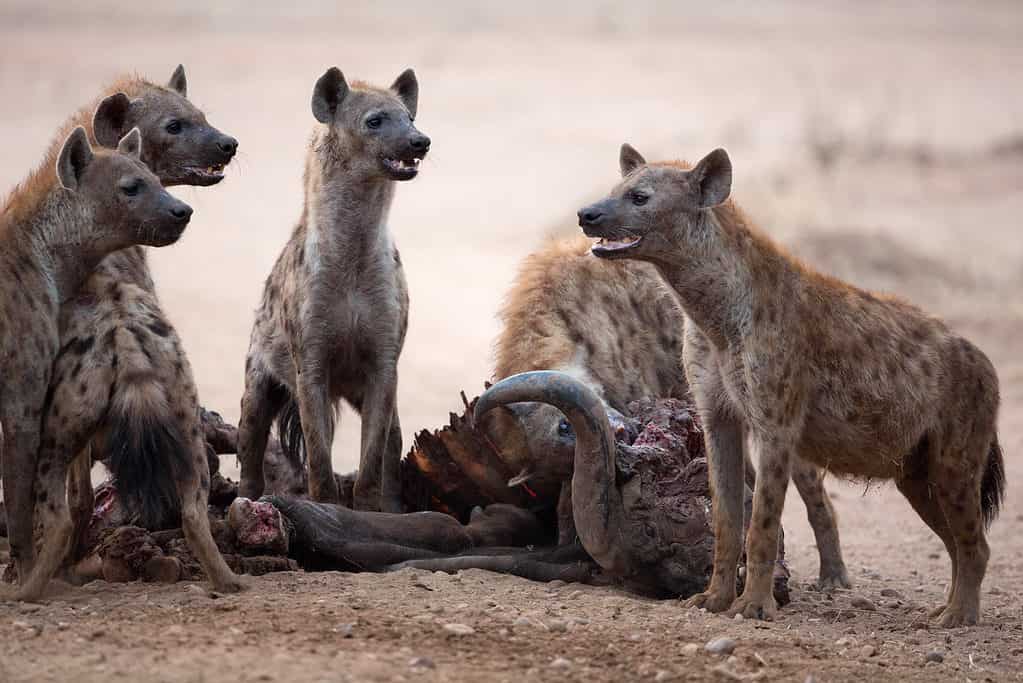
When hunting large prey, spotted hyenas will often hunt cooperatively.
©Jez Bennett/Shutterstock.com
Both scavengers and predators, spotted hyenas exhibit quite flexible hunting strategies. When hunting small game, such as reptiles and birds, hyenas tend to hunt on their own. However, when they prey on large animals, such as wildebeest or antelope, hyenas typically hunt cooperatively in small groups. They tend to hunt in smaller groups to avoid feeding competition, which can be fierce when larger numbers hunt together. Additionally, they will frequently work together to steal prey taken down from another predator, such as a cheetah. When stealing prey from another predator, spotted hyenas can work together to mob the other animal as they take turns harassing it. They dart in and out in a circular pattern that often overwhelms the other predator and leaves it surrounded.
Generally, the larger the spotted hyena clan, the larger prey they will hunt, including wildebeest, zebras, young rhinos, and Cape buffalos. Hyenas will often engage in a hunting behavior called “test chasing”. This strategy involves a clan assessing possible vulnerabilities within a herd of ungulates, such as zebra. They often look for young or weak individuals to single out. During this test chase, if an individual can be quickly singled out, the hyenas will work together to do so, often completing their hunt within minutes of establishing their chosen prey. If the herd moves together effectively with no individuals falling behind, the hyena clan will often end the test chase and move on to another herd. This strategy allows them to conserve energy and hunt in the most advantageous environments.
Vocalizations During Cooperative Hunts
Vocalizations are particularly important for spotted hyenas during group hunts. They use a range of sounds to communicate with their clan members and even to confuse and frighten prey. Whooping, giggling, squealing, and lowing are some of the vocalizations hyenas make during a hunt. Spotted hyenas are known for their incredible endurance. As they spread out over the plains during a chase, they often use whoops, which they can hear up to 3 miles away, to communicate their location to each other. Squeals and giggles can communicate distress or excitement and can be used to bring individuals over to a certain location. The length of the giggle and pitch can distinguish between excitement and distress, and whether the call is directed toward prey or members of the clan.
Animals That Hunt Cooperatively: Bottlenose Dolphins (Tursiops truncatus)
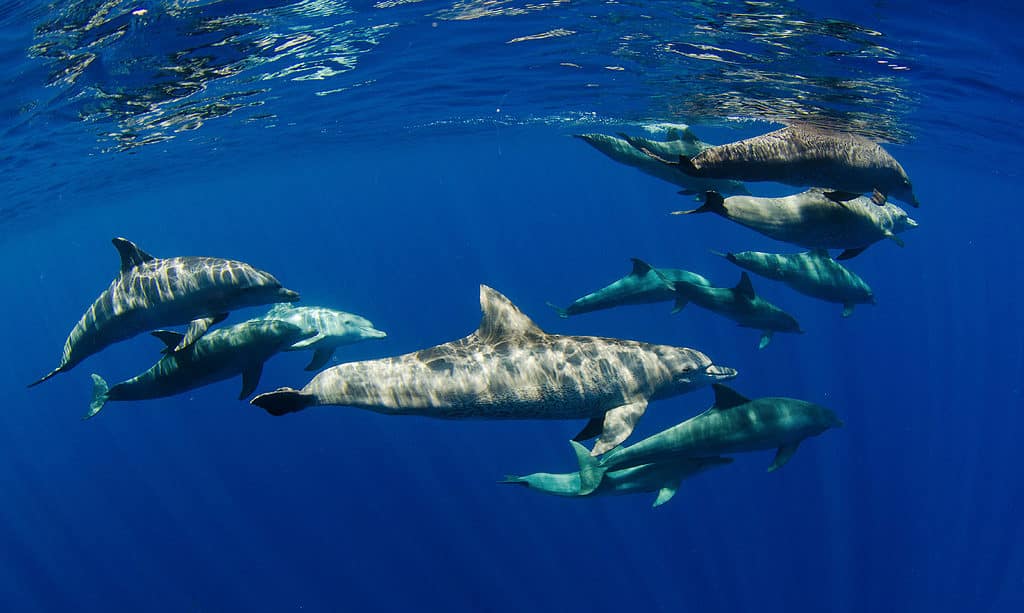
Bottlenose dolphins use intricate communication skills and coordinated agility to cooperatively hunt a range of prey, including schooling fish.
©Joost van Uffelen/Shutterstock.com
Many species of marine animals, both fish and mammals, also hunt cooperatively. The highly intelligent, social bottlenose dolphins (Tursiops truncatus) are particularly skilled at cooperative hunting. They’re also an example of animals that hunt with members of other species, namely that of whales and humans. Studies show that wild dolphins will hunt cooperatively with humans and both species can benefit. One 15-year study on interspecies hunting cooperation between humans and dolphins off the southern coast of Brazil reveals coordination between net casting and herding of prey by dolphins. In this area, human fishers and dolphins have been hunting together for over 140 years.
Studies show that bottlenose dolphins can understand the role of their hunting partners and perform highly synchronized behaviors within the pod in pursuit of prey. Researchers have observed bottlenose dolphins acting in coordination during hunting and feeding via a range of formations and methods. In one method, the dolphins herd schooling fish into a ball. This effectively traps them and makes feeding highly successful and efficient. In another method, dolphins divide into distinct roles, with some individuals driving the fish in a crescent formation while others attack the fish from the sides. They may also coordinate to use embankments to trap the fish. Driving dolphins are also known to use tail slaps. This motions helps frighten and disorient schools of fish, inhibiting the prey’s ability to stay in tight formations.
During hunts, bottlenose dolphins use clicks to echolocate and whistles to communicate with each other. They also use physically communicate with each other using contact, such as bumping, body language, leaping, and tail slapping.
Harris’s Hawks (Parabuteo unicinctus)
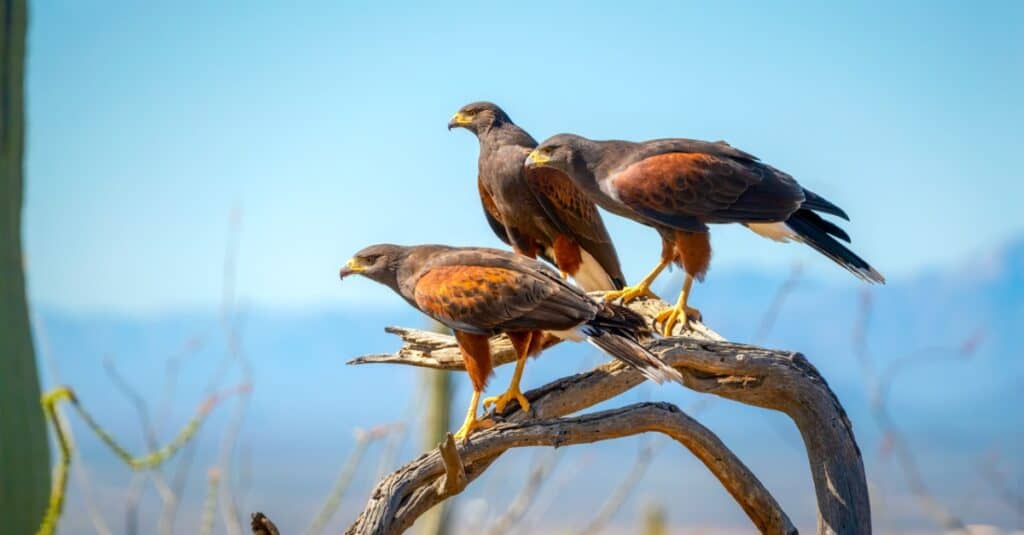
Harris’s hawks are a rare example of social raptors who often live and hunt in small social groups.
©iStock.com/Jay Pierstorff
Typically, raptors live solitary or paired lives. The Harris’s hawk (Parabuteo unicinctus), however, is a distinctly social bird of prey. They frequently live in groups of three or more birds, perching, nesting, raising young, and hunting together. Before raising young, the typical group formation is two males and one female. After brooding, some of the young hawks may stay with the family for up to 3 years. They will hunt together and help raise future broods.
This unique species of hawk lives in semi-arid and arid regions of the southwestern U.S., Mexico, Central America, and South America. They primarily hunt squirrels, birds, reptiles, rodents, and jackrabbits. For Harris’s hawks, cooperative hunting enables more successful prey capture. During a hunt, the hawks use three main methods of cooperation to take down their prey. They may either work together to surround the prey, flush animals out of hiding for a waiting hawk to catch, or they will take turns chasing the prey until the animal is worn down and captured.
Animals That Hunt Cooperatively: Giant Manta Rays (Mobula birostris)
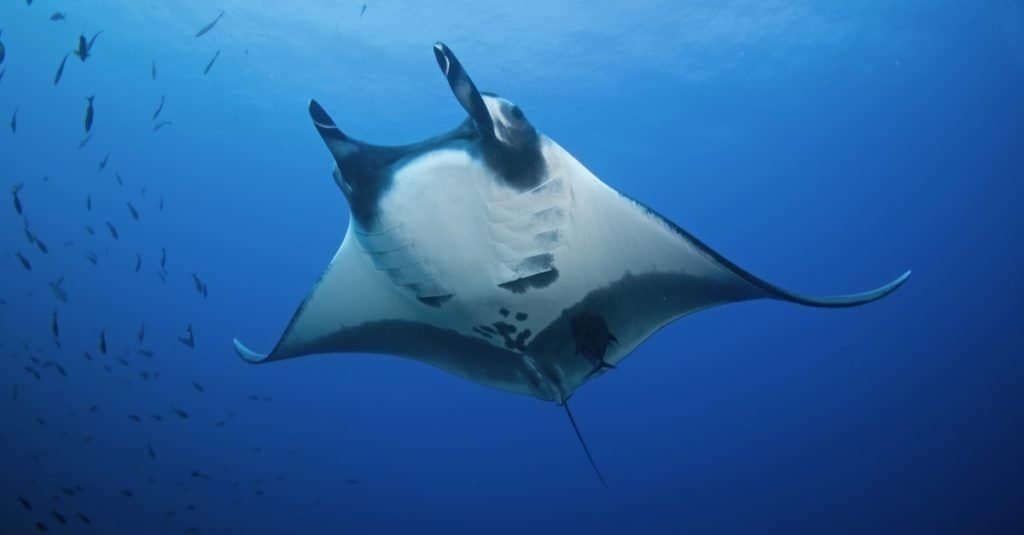
Giant manta rays don’t often hunt cooperatively. However, on rare occasions, they will form coordinated spirals to efficiently capture their planktonic prey.
©Martin Prochazkacz/Shutterstock.com
In contrast to their smaller, social relatives, the reef manta ray (Mobula alfredi), the giant manta ray (Mobula birostris) leads a mostly solitary life. However, they do gather at cleaning sites to feed and mate. Cleaning sites occur at coral reefs in which animals such as wrasse fish and small shrimp pick off bacteria, parasites, and dead skin from the giant manta rays and other marine animals. Both parties benefit as the cleaners get a meal and the giant manta rays leave in healthier conditions.
The primary diet of giant manta rays is planktonic organisms. However, they are known to supplement this filter-based diet with small fish. Typically, giant mantas hunt alone or in small groups. These small groups may feed near each other, but don’t tend to work in unison to catch food. They are somewhat migratory animals, capable of crossing entire oceans following seasonal tidal patterns, current circulations, and the movements of planktonic prey.
Group Hunting in the Maldives
One prime location for migrating giant mantas is the Maldives, an island nation in the north-central Indian Ocean. Here, these gentle giants pass through the southern atolls between March and April. It is in these waters that snorkelers can witness a rare sight- coordinated group hunting of giant manta rays. The Maldives are one of the few locations where researchers have observed social hunting behaviors in giant manta rays. As hundreds of giant mantas descend upon the region, they begin forming an enormous, coordinated spiral. This coordinated movement enhances their ability to filter an abundance of planktonic organisms trapped in the center of the spiral. The feeding tornado also enhanced hydrodynamic efficiency. The coordinated, single-direction movement aids in avoiding collisions as hundreds of these giant animals feed in unison.
Roving Coral Grouper (Plectropomus pessuliferus) and Giant Moray Eels (Gymnothorax javanicus)
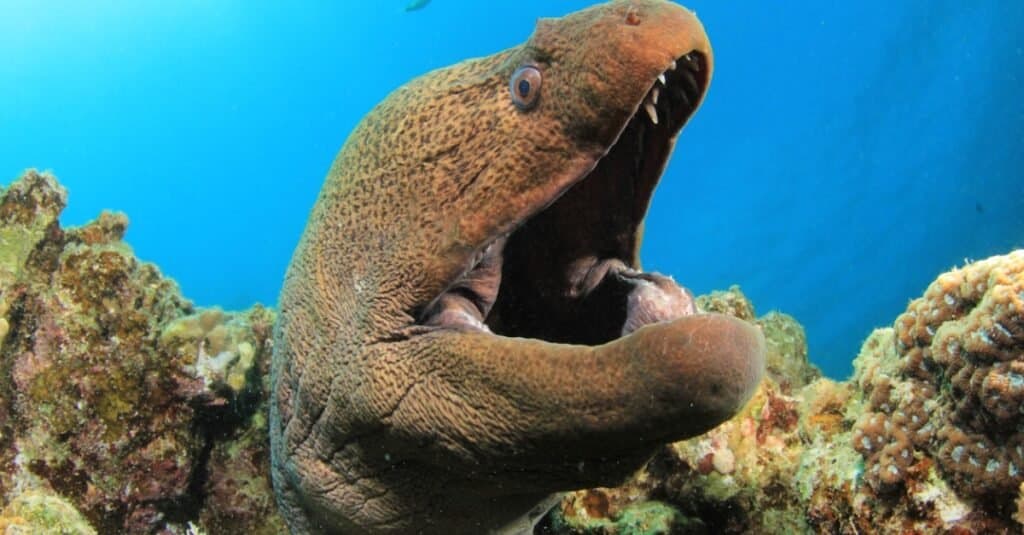
©Rich Carey/Shutterstock.com
The coordinated hunting behavior between the roving coral grouper (Plectropomus pessuliferus) and the giant moray eel (Gymnothorax javanicu) is a highly intriguing example of interspecific cooperative hunting. One study documented this unlikely partnership of roving coral groupers and giant moray eels on coral reefs in the Red Sea.
Researchers found that the distinct hunting strategies of the two species complement each other, allowing for a beneficial predation partnership. The roving coral grouper hunts in open areas of the reefs. In contrast, the moray eel prefers to wind through the tight spaces of the reef system, cornering prey attempting to hide. When these animals work together, the targeted prey faces a coordinated, multi-predator attack from both open areas and coral reef crevices. The eels and groupers often trade off capturing the prey and swallow it whole immediately, avoiding the potential for fighting over a carcass.
To initiate a cooperative hunt, researchers noted that the roving coral grouper will approach the resting place of the giant moray eel. There, the grouper will vigorously shake its head at 3-6 shakes per second directly in front of the moray eel. This is done typically at a distance of a few centimeters. In response, the moray will leave its crevice and the two marine animals will swim off together to hunt.
Animals That Hunt Cooperatively: South American Social Spiders (Anelosimus eximius)
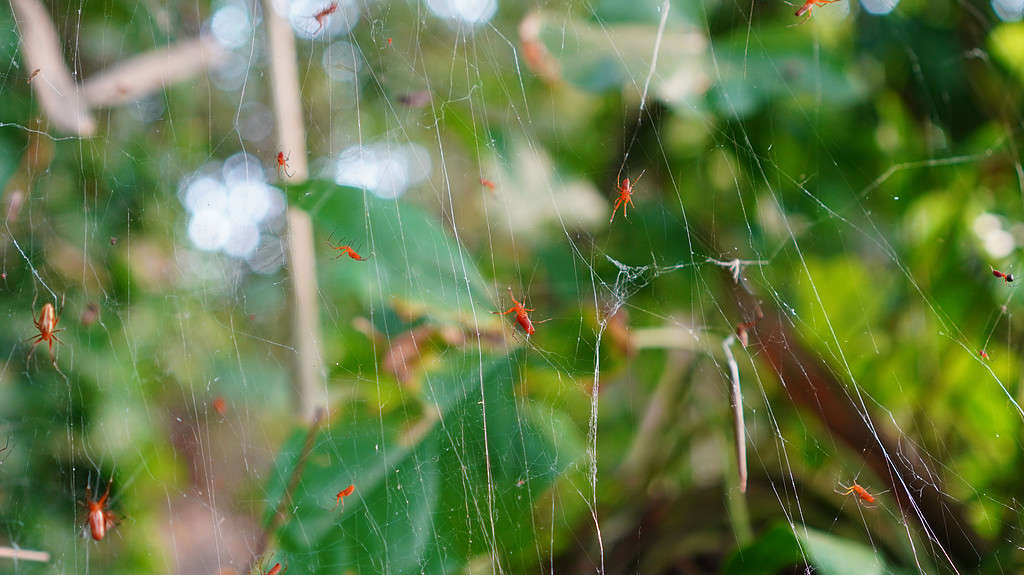
South American social spiders are a rare example of communally-oriented spiders. They live in communal webs and work together to subdue and wrap up large prey.
©wahid hasyim asyari/iStock via Getty Images
The vast majority of spiders live primarily solitary lives. However, out of 50,000 documented species, about 20 display social living and cooperation. One such species is the South American social spider (Anelosimus eximius). These social, communally-oriented spiders live together in enormous communal webs. They maintain and defend the web together, and they also display cooperative hunting strategies.
It’s common to find South American social spider webs that measure 15 feet long and 9 feet tall. These webs house thousands of residents, about 90% being females. In these impressive webs, they communally care for egg sacks and look after their young. By working together in their strong and sticky home, these spiders can take down prey much larger than them. When they hunt cooperatively, these spiders can trap and subdue large insects and even small bats and birds. When an animal becomes caught in their gigantic web, the spiders quickly locate the prey by feeling the vibrations it causes on the web strands. They converge upon the trapped animal, taking turns darting in and injecting venom. As the prey becomes subdued, they work together to quickly wrap their meal up in sticky strands.
Synchronized Movements
What’s even more incredible about these animals is that they not only work together to subdue and wrap up their prey, but they also move in synchronized movements toward the trapped animal. Scientists have discovered that when trapped prey sends out vibrations along the web, it triggers synchronized stop-and-start movements among the spiders. Researchers have recorded that these amazing animals will rapidly move in unison toward the heart of the vibrations, and then they all stop at once. Once an individual senses the vibrations caused by the prey again, she begins to move and all the other spiders immediately follow suit for about a second before stopping again. This start-and-stop synchronized movement allows the spiders to quickly and efficiently locate their prey across a huge web, without unsynchronized movements of other spiders confusing the source of the vibrations.
The photo featured at the top of this post is © Adalbert Dragon/Shutterstock.com
Thank you for reading! Have some feedback for us? Contact the AZ Animals editorial team.







